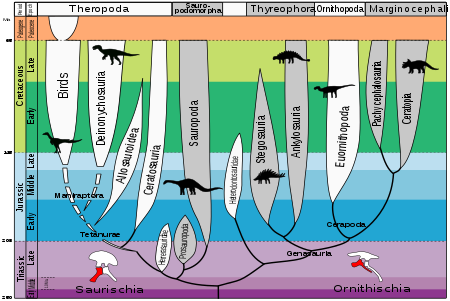
Dinosaur classification began in 1842 when Sir Richard Owen placed Iguanodon, Megalosaurus, and Hylaeosaurus in "a distinct tribe or suborder of Saurian Reptiles, for which I would propose the name of Dinosauria."[1] In 1887 and 1888 Harry Seeley divided dinosaurs into the two orders Saurischia and Ornithischia, based on their hip structure.[2] These divisions have proved remarkably enduring, even through several seismic changes in the taxonomy of dinosaurs.
The largest change was prompted by entomologist Willi Hennig's work in the 1950s, which evolved into modern cladistics. For specimens known only from fossils, the rigorous analysis of characters to determine evolutionary relationships between different groups of animals (clades) proved incredibly useful. As computer-based cladistics matured in the 1990s, paleontologists were among the first zoologists to broadly adopt the system.[3] Progressive scrutiny and work upon dinosaurian interrelationships, with the aid of new discoveries that have shed light on previously uncertain relationships between taxa, have begun to yield a stabilizing classification since the mid-2000s. While cladistics is the predominant classificatory system among paleontology professionals, the Linnean system is still in use, especially in works intended for popular distribution.
- ^ Owen 1842
- ^ Seeley 1888. While the paper was published in 1888, it was first delivered in 1887.
- ^ Brochu, C.A.; Sumrall, C.D. (2001). "Phylogenetic nomenclature and paleontology" (PDF). Journal of Paleontology. 75 (4): 754–757. doi:10.1666/0022-3360(2001)075<0754:PNAP>2.0.CO;2. S2CID 85927950.